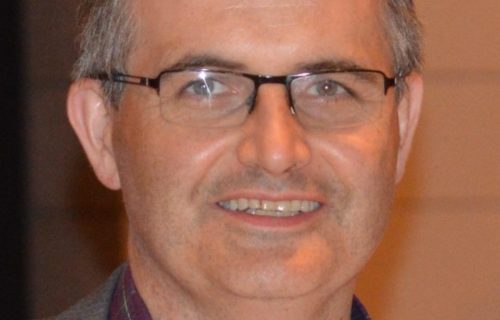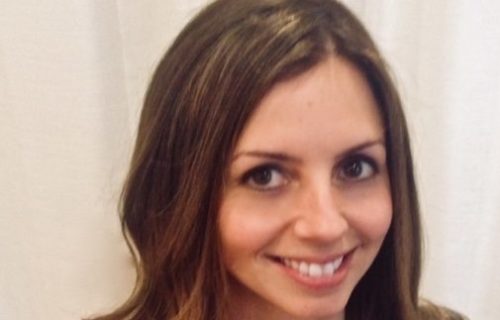Pallium is highlighting fantastic examples of leadership among its network of LEAP™ facilitators to showcase how these palliative care clinicians and educators are improving the delivery of palliative care in their workplaces, regions, and across Canada. It is the passion and dedication of LEAP™ facilitators across Canada that is transforming the way we care for Canadians facing life-limiting illness, and their families.
“Why didn’t anyone tell me this sooner?” After being asked this question by patients with serious illnesses or their family members in nearly every home she visited, palliative care physician, Dr. Samantha Winemaker, began to think about new ways to address the massive gap in patient and family literacy around their health. Dr. Winemaker and her colleague, Dr. Hsien Seow, Canada Research Chair in Palliative Care, began to think of what patients and families needed to know early on in their illness journey, not just at end of life. This was the beginning of The Waiting Room Revolution movement and podcast, which aims to activate and empower patients and families facing serious illness.
Guiding patients and families from the beginning of a life-limiting diagnosis all the way to the end of life isn’t an easy task for health care professionals. What’s more, formal training does not address open, honest, and realistic communication with patients and families leaving many health care providers feeling uncertain how to share difficult information. Throughout an illness journey, patients and family members are often overwhelmed and unsure of what to expect next and they struggle to understand the meaning of the information they receive. Dr. Winemaker describes this, fittingly, as being ‘in the dark’.
Patients do not get to choose their health care provider. Dr. Winemaker explains, “Ultimately patients and families rely on the lottery of the health care provider they end up with…and that health care provider may or may not have taken Pallium’s LEAP™ course or feel competent, comfortable, or skilled to shepherd someone from the beginning of a diagnosis to the end.” As a result, Dr. Winemaker encounters many patients and families in the home with amplified symptoms due to fear and anxiety of not truly understanding what’s happening to them.
Dr. Winemaker describes some patients she meets as “travelling through illnesses for months or years really feeling like they are afloat.” She’ll ask patients their understanding of the illness, where they think they are in their illness, if their mind wanders to the future and wonders what’s going to happen, and if they would like to speak openly and frankly about all these things. Dr. Winemaker says, “They all look at me and ask me if I’m kidding, followed by a series of questions like, what do you mean you know more? Why wasn’t I invited into this conversation sooner?”
Dr. Winemaker and Dr. Seow frequently lamented over shared feelings of not moving the needle fast enough—Dr. Seow was unsure how much of his research was changing the experience of patients with serious illness and their families and Dr. Winemaker was not sure if health care providers were improving their delivery of open, honest, realistic communication with those same patients and families. Both agreed that patients shouldn’t be held at the mercy of a health care team’s comfort or discomfort in providing information that isn’t only positive. They began discussing the concept of leapfrogging over the health care system entirely and delivering public facing information on how to take control of the discussion about serious illness and disease directly to patients and families.
The Waiting Room Revolution movement was born out of an undeniable call to action to ensure patients with serious illness and their families felt more in control and knowledgeable about their illness journeys. The movement is about unlocking the keys to a better illness experience—empowering patients, families, and caregivers to go from unaware to informed, from unsure to confident, from overwhelmed to in control, from scared to hopeful.
Over the course of their careers, Dr. Winemaker and Dr. Seow have met patients and families that did feel in control, confident, and prepared through their illness journeys and were able to help customize their care plans. Distilling and communicating what they had learned from those who were ‘in the know’ versus those ‘in the dark’ was to be a key feature of the messaging of the Waiting Room Revolution movement.
One of the hallmark ways the movement is brought to life is through the Waiting Room Revolution podcast. Through interviews with caregivers, patients, health care providers, and experts, Dr. Winemaker and Dr. Seow explore lived experiences that can help to prepare those who may just be starting their own journey. Episodes cover topics such as coaching patients and families to get the information they need from their health care team. One enlightening moment came while interviewing a caregiver who was told by the care team that her father was going to have a feeding tube. The caregiver recalls being provided with all the information about the feeding tube itself but nothing about what the feeding tube meant in terms of her father’s illness and its trajectory. Dr. Winemaker shares, “Information is not enough. It is the meaning behind the information that is just as important as the information itself. As health care providers, we need to weave all of the information together for our patients and their families.”
When asked to reflect on what has been the most rewarding aspect of launching this movement, Dr. Winemaker says, “This concrete resource now exists.” After describing the joy of working with her partner, Dr. Seow, and interviewing people from around the world she adds that the Waiting Room Revolution movement has been a cathartic, therapeutic outlet for her as someone who has witnessed trauma repeatedly over the course of a career. Dr. Winemaker adds, “I really feel like we have made a product that can actually change the course of someone’s illness and illness experience. That is thrilling.”
Learn more about the Waiting Room Revolution at www.waitingroomrevolution.com.
Samantha Winemaker is a palliative care physician and Pallium LEAP™ facilitator. She is an Associate Clinical Professor, Department of Family Medicine, in the Division of Palliative Care at McMaster University.
Hsien Seow is the Canada Research Chair in Palliative Care and Health System Innovation and an Associate Professor in the Department of Oncology, McMaster University.
Dr. Samantha Winemaker is part of Pallium’s dedicated network of LEAP™ facilitators. From major cities to rural towns, Pallium’s certified facilitators bring their experience, knowledge, and passion to deliver LEAP™ and advocate for better palliative care in their communities. Interested in learning how to implement a palliative care approach into your everyday practice from someone like Dr. Samantha Winemaker? Learn more about Pallium’s suite of LEAP™ courseware.






